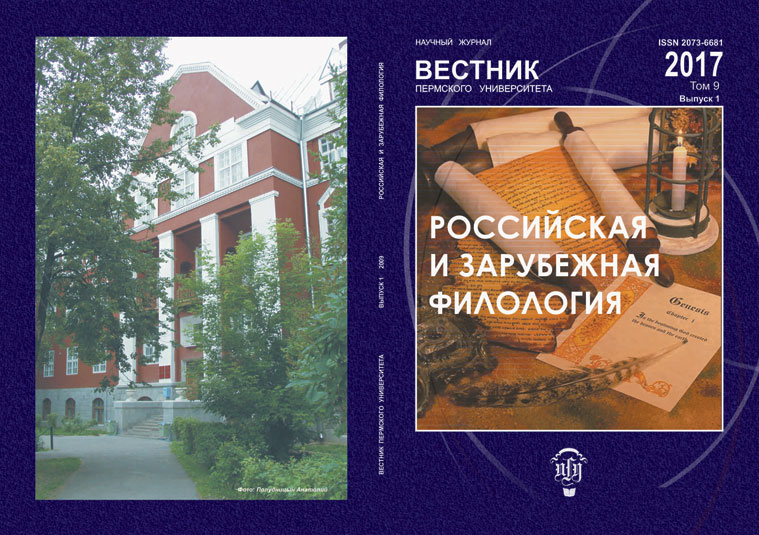ON THE NATIONAL SPECIFICITY OF COLOR SYMBOLISM IN THE RUSSIAN AND CHINESE LANGUAGES
DOI:
https://doi.org/10.17072/2037-6681-2017-1-93-97Keywords:
color symbolism, emotional associations, national culture, color words in the Chinese and Russian languages.Abstract
The article is devoted to the research on the national specific features of color symbolism embodied in color words in the Russian and Chinese languages. In a language system, each color is characterized by cognitive, emotional and information functions for all the peoples of the world. However, in a particular culture each color serves as a special symbol, which can be associated by native speakers with similar or different emotions and reflect rich potential of national cultures. Color words, having symbolic properties, are not only important means to describe the world, but also they perform a cultural-linguistic function to convey emotions of people belonging to different nations. In the Russian and Chinese languages, there are many color words with a strong national flavor. Apart from evoking rich associations and expressing emotional experiences and feelings, they also form a distinct national color culture and have a great influence on human life of the two countries. The vivid contrast between the two languages helps to comprehend the semantic motivation of color words, shades of meanings of color symbolism and cultural identity.References
Базыма Б. А. Психология цвета. Теория и практика. М.: Речь, 2005. 205 с.
Бахилина Н. Б. История цветообозначения в русском языке. М.: Наука, 1975. 288 с.
Бородина М. А., Гак В. Г. К типологии и методике историко-семантических исследований. Л.: Наука, 1979. 232 с.
Брагина А. А. Лексика языка и культура страны. М.: Русский язык, 1981. 176 с.
Булгаков М. А. Мастер и Маргарита. М.: Эксмо, 2010. 816 с.
Воевода Е. В. Цветовосприятие и ассоциативные поля в русском и английском языках // Научный вестник ВГАСУ. 2012. № 2. С. 113–123.
Ву Гохуа Культурная лексикология. Харбин: Хэйлунзянское народное изд-во, 1996. 330 с. // 吴国华. 文化词汇学. 哈尔滨: 黑龙江人民出 版社, 1996. 330 p. (Wu Guohua. Wen hua ci hui xue. Ha er bing: Hei long jiang ren min chu ban she, 1996. 330 p.).
Комлев Н. Г. Компоненты содержательной структуры слова. М.: Едиториал УРСС, 2003. 192 с.
Кульпина В. Г. Система цветообозначений русского языка в историческом освещении // Наименования цвета в индоевропейских языках: Системный и исторический анализ. М.: КомКнига, 2007. С. 126–184.
Новосад А. Характеристики цветов. Тона. Психологическое воздействие цвета. Магия цвета. 2016. URL: http://www.happy-giraffe.ru (дата обращения: 27.08.2016).
Хуан Сухуа Лингвострановедческий словарь русского языка. Пекин: Изд-во «Современный Китай», 2000. 745 с. // 黄苏华. 俄罗斯语言国
情学词典. 北京: 现代出版社, 2000. 745页. (Huang Suhua. E luo si yu yan guo qing xue ci dian. Beijing: Xian dai chu ban she, 2000. 745 p.)
Цун Япин О коннотативном значении цветовых прилагательных в русском языке // Шаньдунское обучение иностранным языкам. 1996. № 3. С. 44–47 // 丛亚平. 俄语中表颜色形容词的词义引申 // 山东外语教学. 1996. № 3. P. 44–47. (Cong Yaping. E yu zhong biao yan se xing rong ci de ci yi yin shen // Shan dong wai yu jiao xue. 1996. № 3. P. 44–47).
Чжан Хуйсэнь Сравнительное изучение русского и китайского языков. Шанхай: Изд-во «Обучение иностранным языкам», 2004. Т. 2. 496 с. // 张会森. 俄汉语对比研究 (下卷). 上海: 外语教育出版社, 2004. 496页. (Zhang Huisen. E han yu dui bi yan jiu. Shanghai: Wai yu jiao yu, 2004. 496 p.)
Чжао Миньшань Разыскания по сопоставлению культурной информации в русском и китайском языках. Шанхай: Изд-во «И Вэнь», 1994. 297 с. // 赵敏善. 俄汉语对比研究. 上海: 译文出 版社, 1994. 297页. (Zhao Minshan. E han yu dui bi yan jiu. Shanghai: Yi wen chu ban she, 1994. 297 p.).
Янь Годун Китайская культура. Тяньцзинь: изд-во «Университет Нанькай», 2000. 303 с. // 阎国栋. 中国文化概观. 天津: 南开大学出版社, 2001. 303 p. (Yan Guodong. Zhong guo wen hua gai guan. Tianjin: Nan kai da xue chu ban she, 2001. 303 p.).
Reference
Novosad A. Kharakteristiki tsvetov. Tona. Psikhologicheskoe vozdeystvie tsveta. Magiya tsveta [Characteristics of colors. Shades. Psychological influence of color. Magic of color]. 2016. Available at: http://www.happy-giraffe.ru (accessed: 27.08.2016).
Bazyma B. A. Psikhologiya tsveta. Teoriya i praktika [Psychologu of colors. Theory and practice]. Moscow, Rech’ Publ., 2005. 205 p.
Bakhikina N. B. Istoriya tsvetooboznacheniya v russkom yazyke [The history of color designation in the Russian language]. Moscow, Nauka, 1975. 288 p.
Borodina M. A., Gak V. G. K tipologii i metodike istoriko-semanticheskikh issledovaniy [On typology and methods of historic-semantic research]. Leningrad, Nauka, 1979. 232 p.
Bragina A. A. Leksika yazyka i kul’tura strany [Vocabulary of the language and culture of the country]. Moscow, Russkij yazyk Publ., 1981. 176 p.
Bulgakov M. A. Master i Margarita [The Master and Margarita]. Moscow, Eksmo Publ., 2010. 816 p.
Voevoda E. V. tsvetovospriyatie i assotsiativnye polya v russkom i angliyskom yazykakh [Perception of colors and associative fields in the Russian and English languages]. Nauchnyy Vestnik VGASU [Scientific Herald of the Voronezh State University of Architecture and Civil Engineering], 2012, issue 2, pp. 113–123.
Wu Guohua. Kul’turnaya leksikologiya [Cultural lexicology]. Harbin, Heilongjiang People’s Publishing House, 1996. 330 p.
Komlev N. G. Komponenty soderzhatel’noj struktury slova [Components of a word’s content structure]. Moscow, Editorial URSS Publ., 2003. 192 p.
Kul’pina V. G. Sistema tsvetooboznacheniy russkogo yazyka v istoricheskom osveshchenii [The system of color designations of the Russian language from the historical perspective]. Naimenovaniya tsveta v indoevropeyskikh yazykakh: Sistemnyj i istoricheskiy analiz [Designation of colors in the Indo-European languages]. Moscow, KomKniga Publ., 2007, pp. 126–184.
Huang Suhua. Lingvostranovedcheskiy slovar’ russkogo yazyka [Russian dictionary of linguistic geography]. Pekin, Sovremennyy Kitay Publ., 2000. 746 p.
Cong Yaping. O konnotativnom znachenii tsvetovykh prilagatel’nykh v russkom yazyke [About the connotative meanings of color adjectives in Russian]. Shan’dunskoe obuchenie inostrannym yazykam [Shandong Foreign Languages Teaching Journal], 1996, issue 3, pp. 44–47.
Zhang Huisen. Sravnitel’noe izuchenie russkogo i kitayskogo yazykov [The comparative study of the Russian and Chinese languages]. Shanghaj, Shanghaj Foreign Language Education Press, 2004, vol. 2. 496 p.
Zhao Minshang. Razyskaniya po sopostavleniyu kul’turnoy informatsii v russkom i kitayskom yazykakh [Contrastive culture information of Chinese and Russian]. Shanghaj, Shanghai Translation Publishing House, 1994. 297 p.
Yang Guodong. Kitayskaya kul’tura [Chinese Culture]. Tianjin, Nankai University Press, 2001. 303 p.




